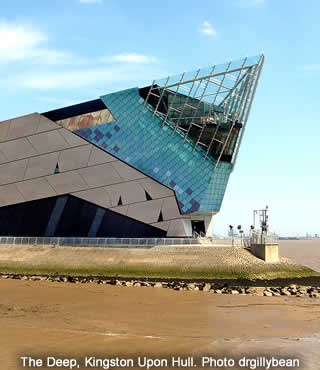Hull |
|
 |
|||
One of England's great harbours |
||||
|
||||
In 1299, this settlement was christened "King's Town Upon Hull", because it was established by King Edward I upon the Hull River. The title has since been squeezed down to "Kingston-upon-Hull", but these days most people just call it Hull. |
||||
It's appropriate that the town is known by the name of its river, because the water has always been this settlement's most important feature. Here, the Hull meets the Humber Estuary, 25 miles from the North Sea. The harbour has acted as a military supply port, a fishing centre and a trading hub. Wool was a popular product, but there are few items that haven't been bought or sold here at some point. |
||||
In a single year, the harbour handles 13 million tonnes of cargo, while the ferries take over a million people between here and mainland Europe. There's a relatively new marina for pleasure craft, with 270 berths for yachts and sailing boats. |
||||
The city's most striking building has a similarly aquatic theme. It's called The Deep, and it describes itself as the world's only submarium (also known as an underwater aquarium). It's home to over 3,500 fish, including sharks and rays. They get their food straight from the hands of the staff members, who are either very brave or very stupid. |
||||
Even Hull's shops look like they'd prefer to be out on the water. Princes Quay, for example, is a shopping centre built on stilts, directly over Prince's Dock. The building's shaped like a ship. It even refers to its floors as "decks". |
||||
The hub of the city's retail scene is St. Stephen's, a behemoth of a centre that cost £160 million to build. Besides the shops, it also contains cultural locations like the Hull Truck Theatre. It was founded by the actor Mike Bradwell, who placed an advert in Time Out magazine saying "Half-formed theatre company seeks other half". Somehow, this optimistic approach resulted in one of East Yorkshire's favourite dramatic societies. |
||||
Not far from here is the Museum Quarter. That it contains plenty of museums isn't especially surprising; a more unexpected point is that all of them are free. Of course, there's a strong focus on the harbour, and it's history. The Arctic Corsair, for example, is a well-travelled 1960s trawler that's now moored permanently on the river. On the guided tour, you'll hear all about the dangers of the Icelandic fishing grounds that the trawlermen once faced. |
||||
At the Hull and East Riding Museum you can see the Hasholme Logboat, Britain's largest surviving prehistoric vessel. Other exhibits take a broader look at the history of the local area, starting with dinosaur bones, and moving on to Iron Age villages and Roman bath houses. |
||||
Wilberforce House is another highlight. It's the birthplace of William Wilberforce, a local hero who made huge contributions towards the abolition of the Trans-Atlantic slave trade. |
||||
Hull's most recognisable landmark is still the Humber Bridge. The 2200-metre-long structure was the largest suspension bridge in the world when it opened in 1981, and it's still the longest bridge you can cross on either foot or bicycle. |
||||
|
Pocket Britain is optimised for use on a smartphone or tablet with internet access. All content is subject to copyright. All reasonable methods have been used to ensure information supplied is accurate at the time of publication. However, it is advisable to check information before relying on it. Privacy Policy |